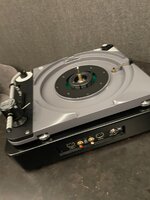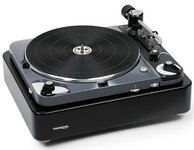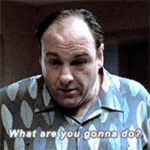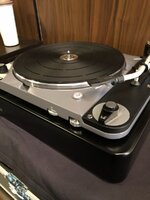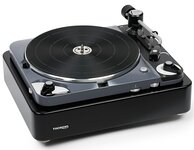So, I'm taking a turn in this "journey" and have decided to opt for an integrated amp at this time instead of separates. I'm looking at the Rotel 1572MKII, specifically. I've also changed the Lintons for the Diamond 12.2, but also looking at the KEF Q350 and the ubiquitous Elac Debut Reference DBR62. Are these speakers "enough" for the Rotel? I know the age-old rule of thumb about how much money to put into speakers vs. the other components would cast doubt on this, but I'm more interested in what the combination would sound like, rather than the individual costs. Thanks for any thoughts here.
You are using an out of date browser. It may not display this or other websites correctly.
You should upgrade or use an alternative browser.
You should upgrade or use an alternative browser.
Equipment Recommendations - The Home For New System and Upgrade Advice
- Thread starter Joe Mac
- Start date
When I was in the business, we were trained to sell systems at 50% speakers, 30% amp and 20% source. It was easy for customers to understand because speakers “are where the sound comes from”.So, I'm taking a turn in this "journey" and have decided to opt for an integrated amp at this time instead of separates. I'm looking at the Rotel 1572MKII, specifically. I've also changed the Lintons for the Diamond 12.2, but also looking at the KEF Q350 and the ubiquitous Elac Debut Reference DBR62. Are these speakers "enough" for the Rotel? I know the age-old rule of thumb about how much money to put into speakers vs. the other components would cast doubt on this, but I'm more interested in what the combination would sound like, rather than the individual costs. Thanks for any thoughts here.
A speaker (assuming it’s a good one) can only put out what it gets. If you look at my system, the majority of the money is tied up in the turntable/cartridge/phono stage. Feed a speaker the best signal you can afford and you may be shocked how good the speaker really is. Feed it a poor signal, and you’ll get a poor result no matter how good the speaker is.
Peter Lederman (Soundsmith) said it best- you won’t get the whole story if you don’t get all the words. The words start with your source.
Food for thought.
Thanks for the post. That budgetary split is what I remember. The only way to know is to listen to them, of course. I guess I wanted a "sanity check" over whether I was in the right ballpark.When I was in the business, we were trained to sell systems at 50% speakers, 30% amp and 20% source. It was easy for customers to understand because speakers “are where the sound comes from”.
A speaker (assuming it’s a good one) can only put out what it gets. If you look at my system, the majority of the money is tied up in the turntable/cartridge/phono stage. Feed a soeaker the best signal you can afford and you may be shocked how good the speaker really is. Feed it a poor signal, and you’ll get a poor result no matter how good the speaker is.
Peter Lederman (Soundsmith) said it best- you won’t get the whole story if you don’t get all the words. The words start with your source.
Food for thought.
Great way to put it.Information lost in the front end will never be replaced is another way to look at situation.
That’s a reimagining I prefer to the original. I hope they got rid of the original’s magnetic platter. It’s a bitch to set VTF on an original.My cousin is working the Montreal HiFi show and he's currently setting up my dream table. He's trying to wound me.
View attachment 170272View attachment 170273
Thorens TD 124 DD
Mather
Unknown Member
I THINK they did? I'm pretty sure they did. They're gunna sell this unit as a demo open box after the show. I'm inquiring. But at a starting price of $12,000 USD I'm not exactly hopeful.That’s a reimagining I prefer to the original. I hope they got rid of the original’s magnetic platter. It’s a bitch to set VTF on an original.
Also I prefer the dark grey plinth to the silver.
MikeH
Well-Known Member
Mather
Unknown Member
Nee Lewman
बैस्टर्ड
The 30n is an SACD/CD player so it has an audio out to connect to amps without a DAC. It also lets you use its DAC for the likes of a streamer which is great because its DAC is likely going to be miles ahead of any built in to an amp. It would want to be though, it costs a lot.
I don’t think it is a preamp though. It doesn’t have the ability to control volume that I can see so it couldn’t really be directly plugged into a power amp. It’d work directly with active speakers because they tend to have an integrated amp with volume control built into them.
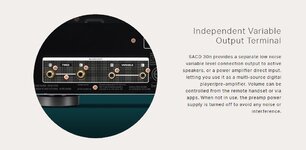
I knew I wasn't crazy, and here is the explanation and how you use the volume. I think my plan is dirac chip, then save up for this bad boy, then preamp (i'm eyeing the EAT E-Glo petit - as much as I'd like this to be after adding dirac, I really want to be sure that I don't need more inputs first), then I'll do speakers (really thinking Fortes) and then a new turntable (we'll see what's available ten years from now when I'm there).
Then I'll try to convince the wife of room treatment. I'll probably die as I hang the last of those tiles.
Last edited:
hearditontheX
New Member
Any recommendations on a record brush? tyia.
Russ I
Well-Known Member
Amazon product ASIN B08113TFRV (currently $10.35)Any recommendations on a record brush? tyia.
OMC
Well-Known Member
Really good for superficial dust, hair, etc. You need something a tad stiffer to get into the grooves for crud that’s a little deeper than surface dirt. Something like the Audioquest carbon fiber brush. Both inexpensive solutions.Amazon product ASIN B08113TFRV (currently $10.35)
kvetcha
Chet Hanks' Filmography Buff
Thunderon all dayAny recommendations on a record brush? tyia.
OMC
Well-Known Member
Going to give one a try.Thunderon all day
Russ I
Well-Known Member
@AnthonyI it's been a while since you posted about this cart, but I'm wondering if you have any recollection of the preamp settings you found to work best for you. I think I've got gain set where it needs to be (60db), but I'm not as confident with my load settings. Everything I've read seems to suggest a wide range of workable possibilities (100 to 25K?!*#@), and I suppose I'll spend some time trying different settings to see if I can notice any significant differences between them, but if you have any wisdom to offer, I'd be happy to receive it!Time to talk about the Denon 103R MC
Cleaned up and wrapped up my notes while listening to music and putting some hours on the Linton's yesterday. 99% of this is based on 30+ hours with the Omens which were completely broken in. Just as a technical side note, on the Manley the Denon is running at a gain of 65 and load of a 159 ohms.
View attachment 85347
The one thing that stuck out right from the get go was how dead silent this cart runs, I'm talking BLACK, BLACK, and it has wonderful tracking. I listened to a variety of things and pressings, Dire Straits for the instrumentation, Norah Jones and Natalie Merchant for their voices and pressings (Acoustic Sounds / MoFi), as well as some OGs. In it's most basic observation the Denon handled everything really well, it performed as expected with "audiophile" pressings and elevated OG pressings from the 70's and 80s, it even brought the notorious highs from the 80's back in check. Imagine Boston's self titled album sounding sublime rather than chringy
Describing the Denon is actually very simple in my opinion, it's been the most organic sounding cart I've used. Instruments, voices, guitar plucks and power cords all have a very natural sound and timbre. The upper end of the bass gets a nice bump as well as the lower end of the midrange, this seems to stand out even more on the Linton's if memory serves.
The imaging does seem a hair narrower, very minor at best, but I did notice it from my listening position. Moving back a bit does start to widen that field and fill the room, so there may be a few things at play here, the Omens might have needed a little tweak with the Denon, but since I'm running the Linton's at the moment I'm going to let those simmer in and then see if I can play with the imaging a bit.
The "downside", and there is only 1 in my opinion and that's the non-replaceable stylus. The formula to debate and discuss this point is going to be different for everyone so I'm going to base these comments on where I see this playing out for me. I've always been a "Bang for your Buck" person, so does the Denon bring enough to the table to dethrone the Opus3 at $100 more ($379 at LP Gear)? Yes, in my opinion the Denon raises the bar on everything across the board enough to justify the cost. This brings us to the cost of wear and tear, what's it going to cost to get this re-tipped? Well, for the Denon I've found it's not such a black and white answer. If you can find a dealer you can get it re-tipped for the cost of the new stylus (I've yet to find this number or dealer), but, Soundsmith does offer re-tipping for non-Soundsmith carts with their styli that starts at $200..........this is an intriguing option, but not without it's drawbacks, the turnaround time.
At the end of the day am I ok with spending about $380 every 12-18 months? I am, the sound quality and reputation of the Denon are well deserved and really have brought the "sound" I've been looking for to my system. I think in the $250-500 price range there are some very solid options to please just about anyone's budget and technical prowess, Being one who wants to "squeeze" everything they can from something and wanting to give an MC cart a go, the Denon seemed inevitable and I'm glad I scratched that itch.
My game plan with the Denon is simple, when the time comes for the stylus I'm going to buy another Denon so I have 2 bodies. When the replacement gets close to its end I'll be sending the Denon to Soundsmith for it's "entry level" replacement and see how that sounds, over time I might go up another rung at Soundsmith if the experiment proves successful, but that's a ways down the line.............and who knows what might pop up in the market
For the time being, the Denon has taken it's place as the "forever" cart based on price and sound. If your pre-amp can handle it I would highly recommend giving the Denon a go, it really does do an amazing job of cleaning up what you thought sounded great and bringing the entire sound field to another level.
............now to finish burning in those Linton's.
Last edited:
OMC
Well-Known Member
Think of the load settings as a small level of tone control. From low to maximum load levels the actual sound differences are not that great, not nearly as profound as a bass or treble control. If your phono stage has easily accessed load settings then experimentation is a snap. The differences are there but minimal in most setups. General rule of thumb is if your system is a little bit thin or treble forward then lower capacitance can add a little body at the lower frequencies and if your system is a might too full bodied a higher load - 10k or higher - might add a little sparkle. Another thing that makes analog fun for those into tweaking.
Last edited:
AnthonyI
Well-Known Member
If memory serves, and I'm like 99% sure, I was running it at 65db with a load of 100 on the Manley and it sounded perfect. I will say, I think I started at 60db because optimal is 62db, but the small bump up did wonders on my set up.@AnthonyI it's been a while since you posted about this cart, but I'm wondering if you have any recollection of the preamp settings you found to work best for you. I think I've got gain set where it needs to be (60db), but I'm not as confident with my load settings. Everything I've read seems to suggest a wide range of workable possibilities (100 to 25K?!*#@), and I suppose I'll spend some time trying different settings to see if I can notice any significant differences between them, but if you have any wisdom to offer, I'd be happy to receive it!(I currently have the Denon mounted on a SME 3009 II unimproved tonearm on a Thorens TD-125 mkII I've pulled out of my basement to utilize a recently purchased Feikert protractor. And as long as I'm trying to dial in perfection (ahem!), figured I might as well play with the phono pre settings as well.)
AnthonyI
Well-Known Member
I think it depends on the system as you mentioned, sometimes a 100 ohm difference yields nothing of note, but sometimes it cleans things up a bit. That said, some pronounced shifts do bring noticeable results. When I had my Hana SL, the recommended load it 400, but running it at 800 brought an audibly positive result.Think of the load settings as a small level of tone control. From low to maximum load levels the actual sound differences are not that great, not nearly as profound as a bass or treble control. If your phono stage has easily accessed load settings then experimentation is a snap. The differences are there but minimal in most setups. General rule of thumb is if your system is a little bit thin or treble forward then lower capacitance can add a little body at the lower frequencies and if your system is a might too full bodied a higher load - 10k or higher - might add a little sparkle. Another thing that makes analog fun for those into tweaking.
To your point, if you can adjust the load easily there's no reason not to play with it a bit, it's not going to hurt anything
